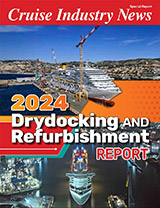Carnival Corporation has ordered four new ships from Fincantieri in a deal estimated at $2 billion.
The agreement calls for one ship each for Holland America Line, Carnival Cruise Lines, Princess Cruises and Costa Crociere.
A 2,044-passenger ship for Holland America, slated to enter service in summer 2008, with an option for a sister ship for spring 2010. The estimated all-in cost is $450 million, according to Carnival, or $220,156 per berth.
A 130,000-ton, 3,600-passenger ship for Carnival for fall 2009, with an option for a sister ship for summer 2010. The estimated cost is $672 million, or $187,000 per berth.
A 3,100-passenger ship for Princess for fall 2008 – a sister ship to the Emerald Princess. The approximate cost is $570 million, or $184,000 per berth.
A 3,000-passenger ship for Costa for delivery in summer 2009 – a sister ship to the Costa Concordia. The estimated cost is $582 million, according to Carnival, or $194,000 per berth.
Market Expansion
With the latest orders, capacity growth picks up compared to the previous guidance.
According to Cruise Industry News, there is no change in the growth forecast for 2006, when the cruise capacity will grow by 5.6 percent, but in 2007 the new growth rate will be 9 percent instead of 8 percent as estimated before; in 2008 the capacity increase will be 8.4 percent compared to 2 percent; 3.6 percent in 2009 compared to 0.6 percent; and 1.7 percent in 2010 compared to the previous guidance of O percent.
By 2010, the world cruise fleet will be able to carry an estimated 17.4 million passengers annually, compared to the previous estimate of 15.5 million.
The market growth is based on new ships being deployed in existing markets with that so-called additive growth being offset by older ships being moved to develop new markets.
North America
According to Carnival, its new ship introductions are spaced out – 14 to 24 months – between new ships, allowing for the new capacity to be more easily assimilated. In addition, Carnival also plans to move older tonnage into new emerging markets, as well as sell older ships, which will further offset is capacity growth.
Norwegian Cruise Line has stated that it will redeploy its older and smaller ships to sister company Star Cruises as new and bigger ships enter service.
Royal Caribbean Cruises has already redeployed ships from its two brands, Royal Caribbean International and Celebrity Cruises, to First Choice, and may continue to do so.
Thus, with new ships offset by deployment changes and withdrawals, the North American cruise capacity grew by only 0.7 percent in 2005. Projections call for capacity to grow by 5.6 percent in 2006; 8.5 percent in 2007, compared to the previous estimate of 7.5 percent; 7.5 percent in 2008, compared to 2.7 percent before; 1.5 percent in 2009, compared to 0 percent; and 2.3 percent in 2010.
By comparison, the North American cruise capacity grew at an average annual rate of 6. 7 percent from 2000 through 2004. By the end of this year (2005), the North American fleet is able to carry approximately 10 million passengers a year, which will grow to nearly 13 million by the end of 2010.
Carnival, of course, has the most flexibility with its 12 cruise brands in North America, Europe and in Australia and with plans to go into the Asia/Pacific as well.
Evolving safety regulations may also force some of the older tonnage out of the market unless market forces do so.
Europe
The estimated European capacity growth will be 3.2 percent in 2006 over 2005, while increasing to 12.6 percent in 2007 from 11.6 percent; 13 percent in 2008 from 0 percent; and 11.4 percent in 2009 from 0 percent.
The European capacity growth is driven by Aida Cruises, Costa, MSC Cruises and P&O Cruises.
The market capacity will grow from an estimated 3 million passengers in 2005 to more than 4 million by 2009.
Scenarios
The continuous entry of new ships into the market will ensure that the industry remains very competitive and that sales, marketing and pricing will continue to be issues.
However, the new ships will also drive industry demand. In addition, they are bigger, more efficient, hence also more profitable, and with the latest technology, more compliant with environmental and other requirements.
Furthermore, the cruise lines always have the option of pulling older, less efficient capacity out of the market.



